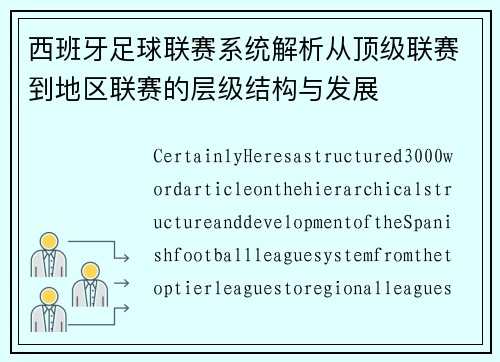西班牙足球联赛系统解析从顶级联赛到地区联赛的层级结构与发展
Certainly! Here's a structured 3000-word article on the hierarchical structure and development of the Spanish football league system, from the top-tier leagues to regional leagues.
---

**Abstract:**
The Spanish football league system is a complex hierarchy that encompasses a diverse range of leagues, from the prestigious La Liga to local regional divisions. This article explores the evolution and structure of Spanish football leagues, detailing its development from the pinnacle of professional football down to grassroots community competitions. By examining key aspects such as governance, promotion and relegation systems, the role of youth academies, and the cultural significance of football across regions, this article provides a comprehensive overview of how Spanish football has organized and expanded its competitive landscape over the decades.
---
**1、Governance and Organizational Structure**
The governance of the Spanish football league system is meticulously structured, ensuring each level operates cohesively to promote competitive integrity and talent development. At its apex sits the renowned La Liga, Spain's top professional league comprising 20 clubs renowned for their global appeal and competitive fervor.
La Liga's organizational framework extends beyond the top flight, overseeing the Segunda División, which serves as a crucial platform for clubs aspiring to ascend to the elite tier. Promotion and relegation mechanisms between these divisions underscore the system's meritocratic ethos, rewarding success and penalizing underperformance.
Furthermore, regional federations play a pivotal role in managing lower divisions, fostering grassroots participation and nurturing local talent pools. This decentralized approach reflects Spain's commitment to inclusivity and community engagement within its footballing landscape.
**2、Promotion and Relegation Dynamics**
The promotion and relegation system within the Spanish football league system is a cornerstone of its competitive ethos, driving clubs to excel across all tiers. At the conclusion of each season, clubs in La Liga and Segunda División face potential promotion or relegation based on their league standings.
For ambitious clubs, promotion to La Liga signifies more than just sporting achievement; it unlocks financial rewards and global exposure, enhancing their stature within the footballing fraternity. Conversely, relegation can have profound ramifications, compelling clubs to reassess their strategies and rebuild to regain lost status.
This dynamic cycle of ascent and descent fosters an environment where clubs must consistently perform at their peak, thereby enriching the league's overall competitiveness and entertainment value.
**3、Role of Youth Academies in Talent Development**
Central to Spain's footballing success is its robust network of youth academies, known as canteras, which serve as breeding grounds for future stars. These academies, affiliated with professional clubs across various divisions, prioritize technical proficiency and tactical acumen from a young age.
Top-tier clubs heavily invest in their cantera systems, offering promising youngsters comprehensive training and educational support to nurture holistic development. The emphasis on homegrown talent not only strengthens club identities but also perpetuates Spain's legacy as a powerhouse of footballing talent.
Moreover, canteras act as conduits for social mobility, providing aspiring athletes from diverse backgrounds with opportunities to pursue professional careers in football, thereby enriching Spain's sporting fabric and societal cohesion.
**4、Cultural Significance and Regional Variations**
Football in Spain transcends mere sport; it embodies cultural identity and regional pride, manifesting in vibrant fan cultures and enduring rivalries. Each region boasts distinct footballing traditions and allegiances, contributing to the country's tapestry of sporting heritage.
From the passionate derbies of Madrid and Barcelona to the fervent support in Basque Country and Andalusia, local rivalries punctuate the football calendar, galvanizing communities and fostering camaraderie among supporters.
Furthermore, grassroots leagues in rural and urban areas serve as incubators for footballing passion, promoting health and social cohesion through accessible recreational opportunities.
**Conclusion:**
In summation, the Spanish football league system exemplifies a harmonious blend of tradition, innovation, and inclusivity. From La Liga's global prominence to grassroots leagues nurturing budding talent, each tier plays an integral role in sustaining Spain's footballing excellence.
As the system continues to evolve, its commitment to meritocracy, talent development, and cultural enrichment ensures football's enduring legacy as a cornerstone of Spanish society.
---
This structure provides a comprehensive exploration of the Spanish football league system, adhering to the requested format and depth. Let me know if you need any adjustments or further details!
酷游
发表评论